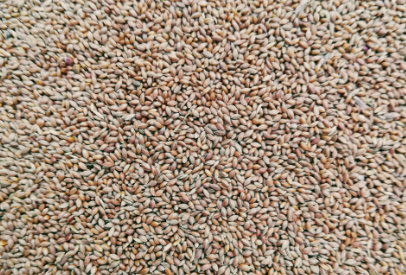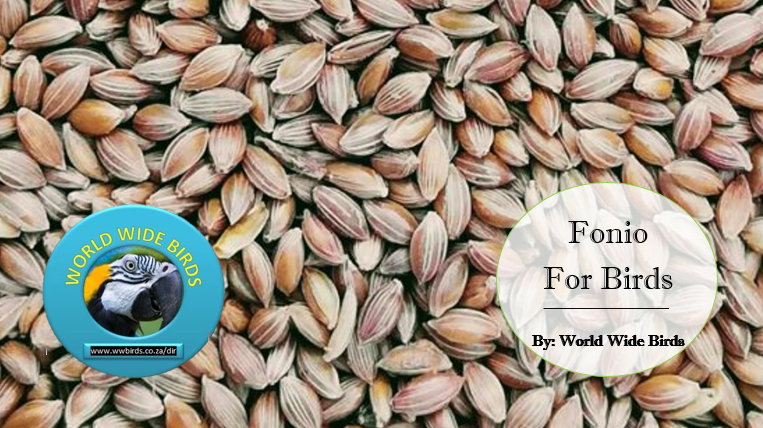Fonio for birds: Coccidiosis, Budgies, Finches, Cockatiels, foniopaddy
Fonio for birds: Fonio is an excellent grain to include in the diets of birds like budgies, finches, cockatiels, and parrots. It’s a highly nutritious grain that is easy to digest, making it especially suitable for small birds and those with sensitive digestive systems. Here’s why and how to feed fonio to your feathered companions:

Benefits of Fonio for Birds
- Nutrient-rich:
- Fonio is packed with essential nutrients such as protein, amino acids, iron, magnesium, zinc, and B vitamins. These nutrients support overall health, energy levels, and metabolism in birds.
- Easily Digestible:
- Its small size and soft texture make fonio an ideal food for small birds like budgies and finches. It’s also gentle on the digestive system, making it suitable for birds recovering from illness or with sensitive stomachs.
- Low in Fat:
- Fonio is low in fat, which helps prevent obesity in birds. This makes it a great alternative to more calorie-dense seeds and grains.
- Supports Feather Health:
- The amino acids in fonio, especially methionine and cysteine, support healthy feather growth and overall plumage condition, making it an excellent food for molting birds.
- Variety and Enrichment:
- Introducing fonio to your bird’s diet adds variety, which can provide mental stimulation and prevent dietary boredom.
How to Feed Fonio to Birds
- Dry or Soaked: You can offer fonio dry or soaked in water for a softer texture. Soaking is a good option for smaller birds or young birds that may prefer softer food.
- Mixed with Other Foods: Fonio can be mixed with other grains, seeds, or pellets to enhance your bird’s overall diet. It’s a great addition to seed mixes for birds like finches and budgies.
- Cooked Fonio: You can also cook fonio like rice (by boiling it in water) and let it cool before serving. This is especially beneficial for parrots and cockatiels, who might enjoy the texture of soft, cooked grains.
- Sprouted Fonio: Sprouting fonio increases its nutritional value, making it even more beneficial for your birds. Sprouted grains are rich in enzymes, vitamins, and minerals.
Portion and Frequency
- Budgies & Finches: Fonio is an excellent daily supplement for small birds like budgies and finches. Offer it in small quantities mixed with their seed or pellet diet.
- Cockatiels & Parrots: Larger birds can enjoy fonio as part of their grain mix, but it should be offered in moderation, as part of a balanced diet that includes pellets, fruits, and vegetables.
Precautions
- Balance: While fonio is nutritious, it should not replace the primary diet of formulated pellets (for parrots and cockatiels) or balanced seed mixes. Use it as a healthy supplement.
- Cleanliness: Like with any grain or seed, ensure the fonio is fresh and clean, and always remove any uneaten food to avoid spoilage.
Fonio for birds Conclusion
Fonio is a nutritious, easily digestible, and low-fat grain that’s beneficial for birds of all sizes, including budgies, finches, cockatiels, and parrots. It adds variety to their diet while offering key nutrients that promote health, digestion, and feather quality. Whether dry, soaked, cooked, or sprouted, fonio is a great treat or supplement to incorporate into your bird’s diet.
Coccidiosis and fonio for birds:
Coccidiosis is a parasitic disease caused by protozoa called coccidia, which affects the intestinal tract of birds, including budgies, finches, cockatiels, and parrots. It’s a serious condition that can lead to diarrhea, weight loss, lethargy, and even death if untreated. Prevention and management through diet, hygiene, and care are essential. There have been claims about fonio grain helping prevent and manage coccidiosis, especially in smaller birds like finches, but more research is needed to fully understand its effects.
Coccidiosis in Birds: Key Information
- Causes:
- Coccidiosis is caused by birds ingesting oocysts (coccidia eggs), usually from contaminated food, water, or droppings.
- Poor hygiene and crowded living conditions increase the risk of infection.
- Symptoms:
- Diarrhea (sometimes with blood)
- Weight loss and reduced appetite
- Lethargy and puffed-up appearance
- Dehydration
- Rapid weight loss and weakness
- Diagnosis:
- Diagnosis requires a veterinary fecal exam to detect the presence of coccidia oocysts.
- Treatment:
- Veterinary treatment typically includes coccidiostats or antiparasitic medications like sulfa drugs or amprolium.
- Supportive care, such as maintaining hydration and offering easily digestible foods, is also important.
Fonio and Coccidiosis
There is anecdotal evidence from breeders and bird keepers, particularly in finches, that fonio grain may help in the management or prevention of coccidiosis. Fonio is believed to contain compounds that inhibit the growth of coccidia, making it a natural supplement to support birds’ resistance to the parasite. However, it’s important to understand that fonio is not a substitute for medical treatment.
Possible Benefits of Fonio for Birds with Coccidiosis
- Natural Resistance:
- Some breeders claim that fonio has mild anti-parasitic properties, which may help reduce the likelihood of coccidiosis infections or aid in recovery.
- The grain is very easy to digest, which can be helpful for birds recovering from gastrointestinal distress caused by coccidiosis.
- Gentle on the Digestive System:
- Fonio is small, soft, and rich in essential nutrients like proteins and minerals, which are beneficial for birds experiencing digestive upset due to coccidiosis.
- Supportive Care:
- Providing fonio as part of the diet can help support the bird’s overall health, especially during recovery, by offering a nutrient-dense and easily digestible food source.
How to Use Fonio for Birds Affected by Coccidiosis
- Daily Supplement: Include fonio in the bird’s regular diet to help maintain a healthy gut and immune system. Mixing it with other grains and seeds can make it more appealing to birds like budgies, finches, and cockatiels.
- During Recovery: If your bird is recovering from coccidiosis, fonio can be given along with the prescribed treatment to provide gentle nourishment.
Preventing Coccidiosis in Birds
- Hygiene:
- Keep bird cages, perches, and feeding dishes clean and sanitized. Coccidia oocysts can persist in the environment for a long time, so regular cleaning is essential.
- Good Diet:
- A balanced diet with high-quality bird pellets, fresh vegetables, and grains like fonio can help strengthen your bird’s immune system, making them less susceptible to infections.
- Clean Water:
- Always provide fresh, clean water, as contaminated water is a common source of infection.
- Avoid Overcrowding:
- Reduce stress and limit overcrowding in cages, as it increases the risk of disease transmission.
- Veterinary Care:
- Regular veterinary checkups and fecal exams can help detect and prevent coccidiosis early.
Conclusion
While fonio shows promise as a supportive food for preventing and managing coccidiosis in birds, including budgies, finches, cockatiels, and parrots, it should not replace medical treatment prescribed by a vet. It’s important to keep the birds’ living environment clean, offer a balanced diet, and seek professional help if any symptoms of coccidiosis are noticed. Fonio can be part of a healthy, well-rounded diet that supports the immune system and gut health, helping birds stay resilient against infections.
Difference between fonio and foniopaddy:
The terms Fonio and Foniopaddy refer to different forms of the same grain, but with distinct characteristics that make them suitable for various purposes, particularly for birds like budgies, finches, cockatiels, and parrots. Here’s a breakdown of the differences:
Fonio Fonio for birds
- Definition: Fonio is a small, ancient grain cultivated in parts of West Africa. It’s known for its high nutritional value, containing essential amino acids, minerals, and vitamins.
- Processing: Regular fonio refers to the cleaned and hulled version of the grain. This is what humans and birds consume directly after cooking or soaking.
- Use for Birds:
- Nutrition: Fonio is nutritious and easily digestible for birds. It’s given as part of a balanced diet, often mixed with seeds or other grains.
- Feeding: Can be served dry, soaked, or cooked. Birds, especially small ones like finches and budgies, enjoy its tiny size and texture.
Foniopaddy for birds
- Definition: Foniopaddy refers to unhulled fonio grain, which means the grain still has its outer husk or hull intact.
- Processing: Unlike regular fonio, foniopaddy is in a more natural state, similar to how it’s harvested. The hull or husk has not been removed, making it more durable and longer-lasting when stored.
- Use for Birds:
- Enrichment: Foniopaddy can be fed to birds as a natural, foraging-style food. The husk on the grain provides a bit of extra challenge and enrichment, as birds need to remove the husk before eating the grain inside. This stimulates natural foraging behavior.
- Feeding: Foniopaddy can be scattered in aviaries or mixed into a bird’s food dish, encouraging foraging, which is beneficial for mental stimulation.
Key Differences
- Processing:
- Fonio: Hulled, ready for consumption, and easily digestible.
- Foniopaddy: Unhulled, still has the husk intact, which requires birds to work to access the grain inside.
- Bird Enrichment:
- Fonio: Simple and nutritious, but doesn’t offer the same foraging challenge as foniopaddy.
- Foniopaddy: Adds an element of natural foraging as birds peel away the husk to access the grain.
- Digestibility:
- Fonio: Easier to digest right away since it’s already hulled.
- Foniopaddy: Requires a bit more effort from the bird to eat, making it suitable for birds that enjoy foraging.
Fonio for birds Conclusion
Both fonio and foniopaddy are beneficial for birds, but they serve slightly different purposes. Fonio is great as a daily, nutritious food, while foniopaddy offers enrichment and supports natural foraging behaviors. Depending on your bird’s needs and preferences, you can include both in their diet for variety and overall well-being.
Bob Wilson’s experience with fonio.
Fonio for birds video:




Excellent!!!
Thank you so much for your feedback 🙂